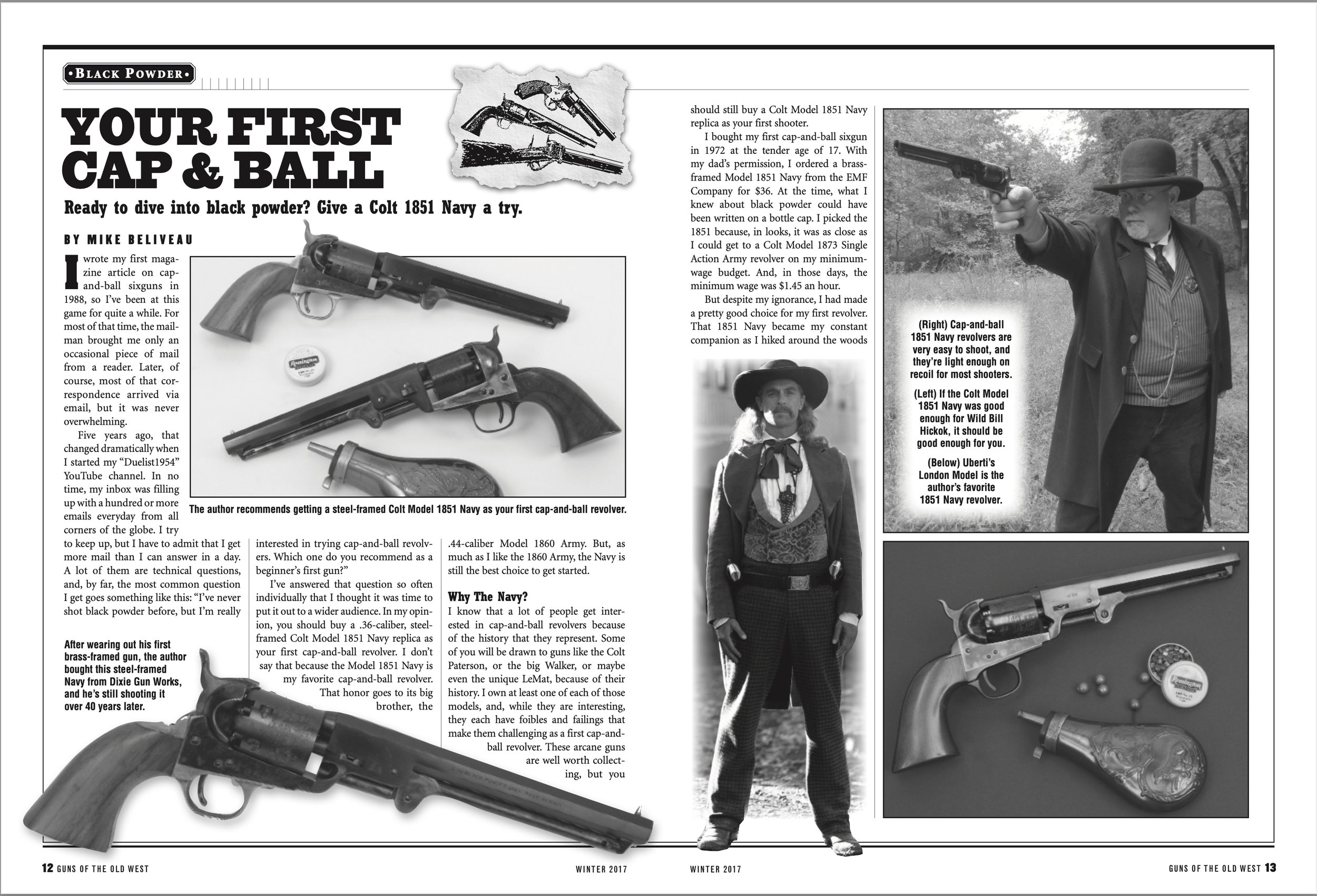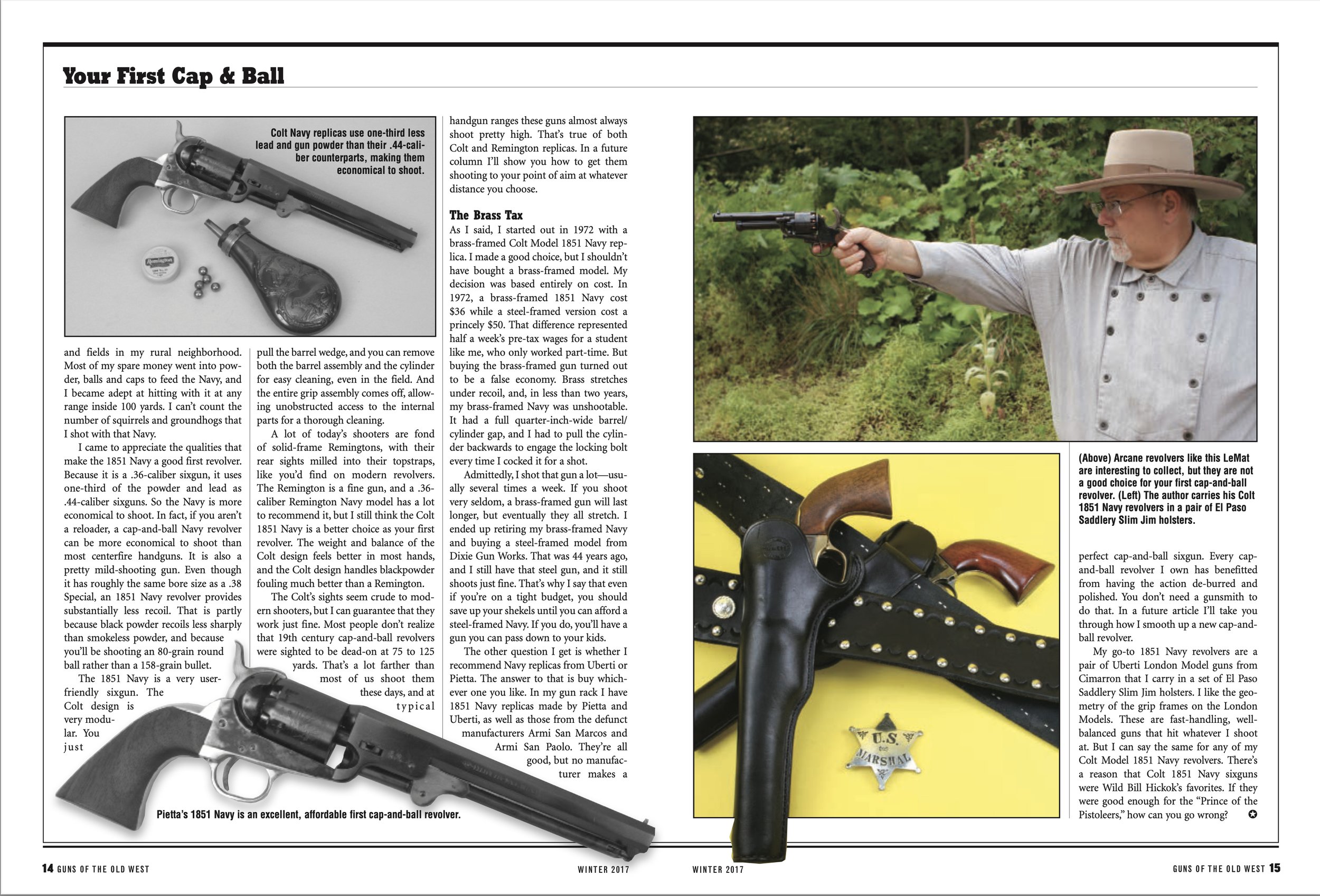Your First Cap & Ball
Ready to dive into black powder? Give a Colt 1851 Navy a try
I wrote my first magazine article on cap and ball sixguns in 1988, so I’ve been at this game for quite awhile. For most of that time the mailman brought me only an occasional piece of mail from a reader. Later, of course, most of that correspondence arrived via email, but it was never overwhelming.
Five years ago that changed dramatically when I started my YouTube channel, Duelist1954. In no time my inbox was filling up with a hundred or more emails everyday from all corners of the globe. I try to keep up, but I have to admit that I get more mail than I can answer in a day. A lot of them are technical questions, and, by far, the most common question I get goes something like this:
“I’ve never shot black powder before, but I’m really interested in trying cap and ball revolvers. Which one do you recommend as a beginner’s first gun?”
I’ve answered that question so often individually that I thought it was time to put it out to a wider audience. In my opinion, you should buy a .36 caliber, steel-framed 1851 Navy model as your first cap and ball revolver. I don’t say that because the 1851 Navy is my favorite cap and ball revolver. That honor goes to its big brother, the .44 caliber 1860 Army. But, as much as I like the 1860 Army, the Navy is still the best choice to get started.
I know that a lot of people get interested in cap and ball revolvers because of the history that they represent. Some of you will be drawn to guns like the Colt Paterson, or the big Walker, or maybe even the unique LeMat, because of their history. I own at least one of each of those models, and, while they are interesting, they each have foibles and failings that make them challenging as a first cap and ball revolver. These arcane guns are well worth collecting, but you should still buy a Colt 1851 Navy replica as your first shooter.
I bought my first cap and ball sixshooter in 1972 at the tender age of 17. With my dad’s permission, I ordered a brass-framed, 1851 Navy from the E.M.F. Company for $36. At the time, what I knew about black powder could have been written on a bottle cap. I picked the 1851 because, in looks, it was as close as I could get to a Colt Single Action Army revolver on my minimum-wage budget. And, in those days, minimum wage was $1.45 an hour.
But, despite my ignorance, I had made a pretty good choice for my first revolver. That 1851 Navy became my constant companion as I hiked around the woods and fields in my rural neighborhood. Most of my spare money went into powder, balls and caps to feed the Navy, and I became adept at hitting with it at any range inside 100 yards. I can’t count the number of squirrels and ground hogs that I shot with that Navy.
I came to appreciate the qualities that make the 1851 Navy a good first revolver. Because it is a .36 caliber sixgun, it uses one third of the powder and lead as .44 caliber sixguns. So the Navy is more economical to shoot. In fact, if you aren’t a reloader, a cap and ball Navy revolver can be more economical to shoot than most centerfire handguns. It is also a pretty mild shooting gun. Even though it has roughly the same bore size as a .38 Special, an 1851 Navy revolver provides substantially less recoil. That is partly because black powder recoils less sharply than smokeless powder, and because you’ll be shooting an 80-grain round ball rather than a 158-grain bullet.
The 1851 Navy is a very user-friendly sixgun. The Colt design is very modular. You just pull the barrel wedge, and you can remove both the barrel assembly and the cylinder for easy cleaning, even in the field. And the entire grip assembly comes off allowing unobstructed access to the internal parts for a thorough cleaning.
A lot of today’s shooters are fond of the Remington’s solid-frame design with a rear sight milled into the revolver frame’s top strap, like you’d find on modern revolvers. The Remington is a fine gun, and a .36 Remington Navy model has a lot to recommend it, but I still think the 1851 Navy is a better choice as your first revolver. The weight and balance of the Colt design feels better in most hands, and the Colt design handles black powder fouling much better than a Remington.
The Colt’s sights seem crude to modern shooters, but I can guarantee that they work just fine. Most people don’t realize that nineteenth century cap and ball revolvers were sighted to be dead-on at 75 to 125 yards. That’s a lot farther than most of us shoot them these days, and at typical handgun ranges these guns almost always shoot pretty high. That’s true of both Colt and Remington replicas. In a future column I’ll show you how to get them shooting to point of aim at whatever distance you choose.
As I said, I started out in 1972 with a brass-framed 1851 Colt Navy replica. I made a good choice in the 1851, but I shouldn’t have bought a brass-framed model. My decision was based entirely on cost. In 1972 a brass-framed 1851 cost $36 while a steel-framed version cost a princely $50. That difference represented half a week’s pre-tax wages for a student like me who only worked part-time. But buying the brass-framed gun turned out to be a false economy. Brass stretches under recoil, and, in less than two years, my brass-framed Navy was un-shoot-able. I had a full quarter-inch wide barrel cylinder gap and I had to pull the cylinder backwards to engage the locking bolt every time I cocked it for a shot.
Admittedly, I shot that gun a lot, several times a week, usually. If you shoot very seldom, a brass-framed gun will last longer, but eventually they all stretch. I ended up retiring my brass-framed Navy, and buying a steel-framed model from Dixie Gun Works. That was 44 years ago, and I still have that steel gun from DGW, and it still shoots just fine. That’s why I say that even if you’re on a tight budget, you should save up your shekels until you can afford a steel-framed Navy. If you do, you’ll have a gun you can pass down to your kids.
The other question I get is whether I recommend Uberti or Pietta Navies. The answer to that is buy whichever one you like. In my gun rack I have 1851 Navy replicas made by Pietta and Uberti, as well as by the now defunct manufacturers, Armi San Marcos and Armi San Paolo. They’re all good, but no manufacturer makes a perfect cap and ball sixgun. Every cap and ball revolver I own has benefitted from having the action de-burred and polished. You don’t need a gunsmith to do that. In a future article I’ll take you through how I smooth up a new cap and ball revolver.
My go-to 1851 Navies are a pair of Cimarron’s Uberti’s London Model guns that I carry in a set of El Paso Saddlery Slim Jim holsters. I like the geometry of the steel grip frames on the London Model. These guns are fast handling, well balanced and they hit what I shoot at. But I can say the same for any of my 1851 Navy revolvers. There’s a reason that 1851 Navies were Wild Bill Hickok’s favorites. If they were good enough for The Prince of the Pistoleers, how can you go wrong?
1851 Navy revolver
Caliber: .36
Barrel: 7 1/2 inches
OA Length: 13 inches
Weight: 2 pounds 12 ounces
Capacity: 6 rounds
Sights: Brass cone front sight, hammer nose rear sight
Finish: Color case hardened frame, hammer and loading lever, blued steel barrel, Standard models have brass grip frames, London models have blued steel grip frames
Action: Single action revolver
Stocks: One-piece walnut
Points of contact:
Cimarron Firearm Company
105 Winding Oaks Road
P.O. Box 906
Fredericksburg, TX 78624
Dixie Gun Works Inc.
1412 West Reelfoot Ave.
Union City, TN 38218
800-238-6785
El Paso Saddlery Co.
2025 E. Yandell
El Paso, TX 79903
915-544-2233

